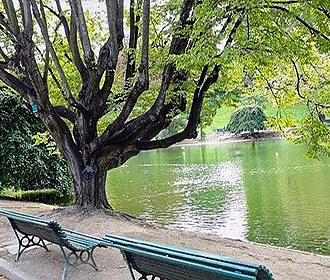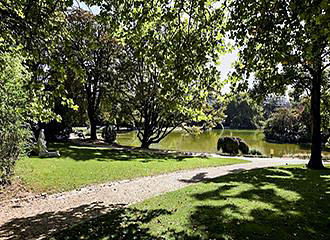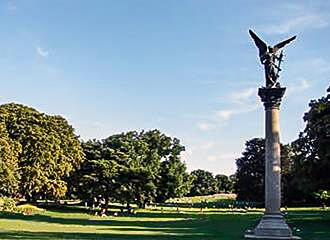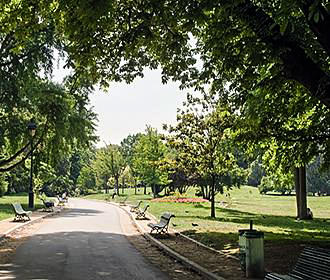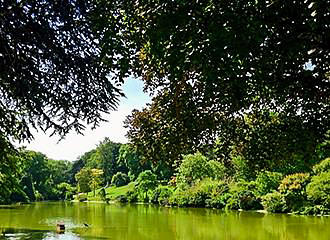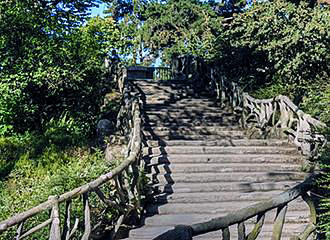Paris Parc Montsouris Park in France
Created during the reign of Napoleon III, the Paris Parc Montsouris Park in France is designed along that of an English garden with green spaces and a lake, but there are also many bronze and stone statues to discover along with wildlife, the bandstand and the Theatre de Guignol du Parc Montsouris.
Parc Montsouris history
Mont is the name for hill or mound and souris is the word for mice in French, and the name of this Paris park is derived from a time when there were mills located on this area that were infested with rodents plus the fact that are steeps slopes.
However, the Paris Parc Montsouris Park in France was also the site of an old quarry, and part of which became the Paris catacombs as a make shift cemetery for many millions of people, but this was well before it became a park.
Yet it was during the Second Empire under the reign of Napoleon III, he entrusted a project to Baron Haussmann in which to transform the city, which included the construction of many promenades and parks in Paris for all to enjoy, along with better sanitation and housing.
Along with the Paris Parc Montsouris, the Parc des Buttes-Chaumont and others were created and the architect and engineer Jean-Charles Alphand was given the huge task of designing these green spaces where people of all classes could mingle.
Napoleon III had the idea of getting rid of the Paris slums and creating these green spaces all over the city, just like the English parks in London. And Jean-Charles Alphand succeeded in creating this 15 hectare English style garden, which was completed in 1878 and still retains the steep slopes from its past, yet provides a vast area of lawns and a lake.
About the Paris Parc Montsouris park today
Below the grassy lawns are hidden several air raid shelters from World War I, but today the Paris Parc Montsouris park in France is now frequented by many students in summer from the nearby university that sit and relax, have lunch and study.
Also here you can enjoy the shade from around 1400 trees, and one Ginkgo Biloba named the Tree of Forty Crowns, is the largest tree on the lake. And yes it has a lovely large lake with an island in the middles that is home to numerous species of birds and other wildlife including mallards, swans, coots, jays, nuthatches and even turtles, which makes this a tranquil spot in the heart of the city.
However, there are also areas to sit on benches or play games, and you can wander through the different areas, over bridges, discover intimate corners, elevated viewpoints, ramps and waterfalls. Plus it also joins the green belt and wild area of a former railway line where the old tracks are hidden in ravines surrounded by trees, which also makes this a haven for wildlife.
In addition to these points, the Paris Parc Montsouris park in France is home to the meteorological observatory of Montsouris, called the Observatoire Meteorologique de Montsouris, and a stone obelisk that stands approximately 5 metres high that is a marker of the meridian of Paris.
There are also childrens play areas, a bandstand that is often home to different musical events and concerts during the summer months, and the Theatre de Gugnol du Montsouris, which is a puppet show theatre in Paris, plus there are several impressive sculptures.
Sculptures inside the Paris Parc Montsouris
There are several stone and bronze sculptures dotted over this Paris park and in the lower part of the park by the Avenue Reille you will find the Colonne de la Paix Armee, which translates to Column of the Peace Army, that was produced by Jules Coutan in 1887 along with a sculpture called Premier Frisson, or First Thrill that was produced by Rene Baucour in 1921.
At the foot of the hill by the Avenue Reille you can discover the Mort du Lion, or Death of a Lion, that was produced by Edmon Desca back in 1929. Yet on the lawn above the lake you can see the statue entitled Groupe de Baigneuses that translates to Group of Bathers, sculpted by Maurice Lipsi in 1952 and Naufrages or Castaway by Antoine Etex, that dates from 1859 that overlooks the lake to the right.
Venturing to the upper part of the Paris Parc Montsouris park at the top of the hill you can discover the Drame au Desert, which translates to Drama in the Desert that was produced by Georges Garden in 1891. In addition to this, there is the Carriers or Accident de la Mine sculpted by Henri Bouchard in 1900, and a more modern sculpture produced by Valsensis Costa in 1955 called Purete, or Purity in English.
But skirting the Boulevard Jourdan you can admire the equestrian statue of General San Martin that was produced by Van Peborgh in 1960 and the bronze statue of Thomas Paine produced by Borglum in 1934.
Access to the Paris Parc Montsouris Park in France
Now the Paris Parc Montsouris park in France is open all year round, and this park has some areas that are accessible to the disabled, but there are some areas that do remain out of reach for those with mobility problems.
When it comes to Paris public toilets, these are located towards the top of the great lawn and there is another set of public conveniences that have just been renovated which are located just after the entrance at the corner of Avenue Reille and Rue Gazan.
The Paris Parc Montsouris park in France is situated within the 14th Arrondissement and can be accessed via the Boulevard Jourdan, the Avenue Reille, the Rue Gazan, the Rue de la Cite Universitaire, the Rue Nansouty and the Rue Emile Deutch de la Meurthe.
Now the closest Metro station is called the Porte d’Orleans. However if you are travelling via the RER train, you would need the Cite Universitaire stop, by tram it is the T3A line and by the Paris bus system you would need numbers 21, 62, 88, 216 and 513 that will get you close to this park.
